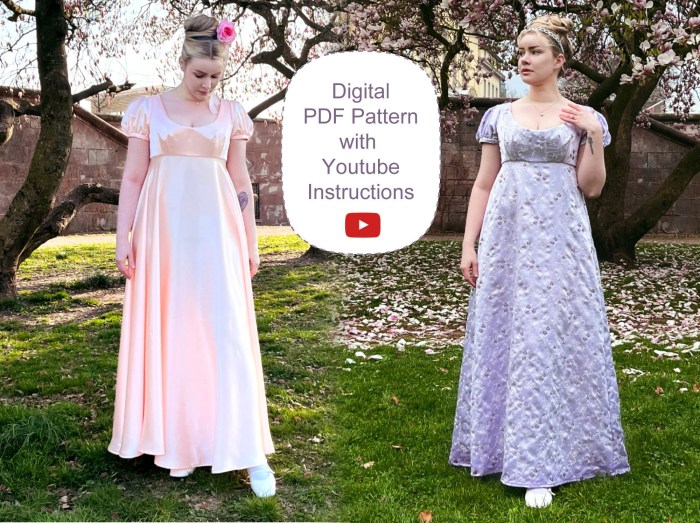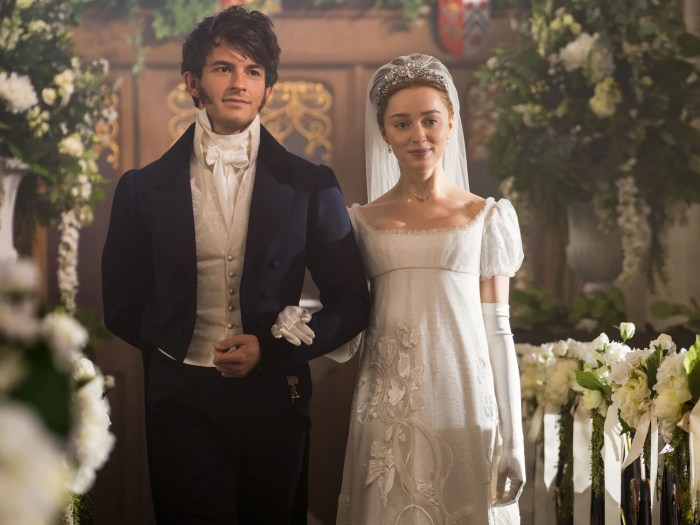Regency Style Wedding Dresses A Timeless Elegance
Regency Style Wedding Dresses: A Timeless Elegance
Regency style wedding dresses – The Regency era, spanning from 1811 to 1820, witnessed a flourishing of fashion, characterized by elegance, simplicity, and a focus on the female form. Regency wedding dresses, reflecting this aesthetic, offer a unique blend of romanticism and refined sophistication. This exploration delves into the defining characteristics of these gowns, their construction, embellishments, and their enduring influence on modern bridal fashion.
Defining Regency Style Wedding Dresses
Regency fashion emerged from the lingering influence of Neoclassicism, emphasizing a return to classical Greek and Roman styles. This translated into a shift away from the elaborate, heavily structured gowns of the previous eras. The Regency silhouette was characterized by a high waistline, often just below the bust, creating a flowing, almost Grecian drape. Fabrics like fine muslin, silk, and lace were favored, often combined to create intricate textures and delicate effects.
Regency style wedding dresses often featured high necklines and long sleeves, emphasizing a sense of demure elegance. A prime example of a dress reflecting this era’s aesthetic, albeit with a touch of modern flair, is princess Margaret’s wedding dress , which incorporated some of the period’s design elements. However, the evolution of Regency style also saw variations in silhouette and embellishment, showcasing a range of interpretations throughout the period.
Embellishments were subtle yet luxurious, featuring delicate embroidery, hand-painted details, and strategically placed ribbons or jewels.
In contrast to the Victorian era’s fuller skirts and elaborate embellishments, or the Edwardian era’s S-bend silhouette and more structured bodices, Regency gowns possessed a lighter, more fluid quality. The evolution throughout the era saw a gradual shift in sleeve length and neckline styles, with higher necklines and long sleeves giving way to slightly lower necklines and shorter sleeves towards the end of the period.
However, the high waistline remained a consistent feature.
Fabrics and Construction of Regency Wedding Dresses

Source: etsystatic.com
The choice of fabric played a significant role in conveying social status and personal style. The delicate nature of the fabrics required skilled craftsmanship. Construction involved meticulous hand-sewing techniques, often employing fine seams and delicate gathers to create the desired silhouette. Seams were often concealed, creating a smooth, unbroken line. The construction techniques focused on creating a flowing, graceful drape, avoiding excessive stiffness or structure.
| Fabric | Properties | Suitability for Wedding Dresses | Examples |
|---|---|---|---|
| Silk | Luxurious, lustrous, drapes well | Excellent, suitable for formal occasions | Silk taffeta, silk satin |
| Muslin | Lightweight, breathable, sheer | Suitable for warmer climates, often used as an underlayer | Fine muslin, sheer muslin |
| Lace | Delicate, intricate, adds texture | Used for embellishment, trims, or as a primary fabric | Honiton lace, Alençon lace |
| Linen | Durable, strong, less delicate than silk | Suitable for less formal occasions or as a lining | Fine linen |
Sleeve styles ranged from long, fitted sleeves to shorter, puffed sleeves, often finished with frills or lace. Necklines varied, including high, round necklines, square necklines, and V-necklines, often accented with delicate lace or embroidery.
Embellishments and Accessories in Regency Wedding Dresses
Embellishments were used sparingly but effectively to enhance the gown’s elegance. The choice of embellishments and color palette often reflected the bride’s social standing and the formality of the occasion.
- Delicate embroidery: Often floral motifs or abstract patterns, adding a touch of artistry.
- Hand-painted details: Subtle floral designs or scenes, adding a unique and personalized touch.
- Ribbons and sashes: Used to accentuate the waistline or add a pop of color.
- Lace: A common embellishment, adding texture and delicacy.
- Beading: Used sparingly, often for subtle highlights.
Accessories included delicate veils, long gloves, and simple yet elegant jewelry. Brighter colors and more elaborate embellishments might indicate a higher social standing, while simpler gowns in muted tones suggested a more modest background.
Modern Interpretations of Regency Style Wedding Dresses

Source: xogrp.com
Modern designers frequently draw inspiration from Regency style, adapting its key elements to create contemporary wedding gowns. The high waistline, flowing silhouette, and use of delicate fabrics remain popular features. However, modern interpretations often incorporate more modern cuts, necklines, and embellishments.
- A flowing A-line gown with a high waistline, crafted from silk chiffon and accented with delicate lace appliqués.
- A fitted bodice with a high neckline, paired with a flowing skirt in silk crepe, featuring subtle beading along the neckline.
- A modern take on the empire waist, using a lightweight silk fabric with a delicate floral print, and featuring long, flowing sleeves.
Illustrating Regency Wedding Dresses
Imagine a gown of ivory silk, its delicate fabric flowing gracefully from a high waistline, creating a soft, romantic silhouette. Delicate floral embroidery adorns the bodice, subtly hinting at a springtime wedding. Long, sheer sleeves, edged with delicate lace, add a touch of ethereal beauty. The overall aesthetic is one of understated elegance and timeless grace, conveying a sense of refined simplicity and romantic charm.
Picture a sun-drenched garden party, the air filled with the scent of roses and honeysuckle. The bride, radiant in her Regency-inspired gown, stands amidst a gathering of elegantly dressed guests. The soft strains of a string quartet fill the air, creating a backdrop of gentle elegance. The overall atmosphere is one of joyous celebration and refined sophistication.
The bride sits before a dressing table, the scent of lavender and rosewater filling the air. The soft silk of her gown flows over her fingers as she adjusts the delicate lace at her neckline. The gentle rustle of silk and the clinking of her jewelry create a quiet symphony of preparation. The feel of the cool silk against her skin, the scent of the flowers, and the anticipation in the air combine to create a sensory experience rich in detail and emotion.
A vision of a sunlit ballroom, adorned with lush floral arrangements and shimmering chandeliers. The bride, resplendent in her ivory silk gown with delicate embroidery, stands beside her groom, their happiness palpable. Guests in elegant attire mingle, their laughter echoing through the space. The scene is a testament to the enduring appeal of Regency-inspired elegance, a timeless celebration of love and beauty.
Common Queries
What is the typical color palette for a Regency wedding dress?
While white wasn’t universally adopted as the bridal color until later, pale shades of ivory, cream, and off-white were common. Subtle pastel shades and even delicate colors like blush pink or light blue were also seen, reflecting the wearer’s social standing and personal preference.
How long did it take to make a Regency wedding dress?
The time required varied depending on the complexity of the design and embellishments. A simpler gown might take several weeks, while a highly embellished dress could take several months, often requiring the skills of multiple seamstresses.
Where can I find inspiration for modern interpretations of Regency wedding dresses?
Fashion magazines, bridal boutiques specializing in vintage or historical styles, and online resources featuring historical fashion blogs and Pinterest boards are excellent sources of inspiration. Many contemporary designers draw inspiration from Regency styles, offering modern interpretations that retain the elegance and charm of the original designs.



















